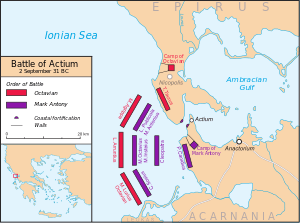31 BC
| Millennium: | 1st millennium BC |
|---|---|
| Centuries: | 2nd century BC – 1st century BC – 1st century |
| Decades: | 60s BC 50s BC 40s BC – 30s BC – 20s BC 10s BC 0s BC |
| Years: | 34 BC 33 BC 32 BC – 31 BC – 30 BC 29 BC 28 BC |
| 31 BC by topic |
| Politics |
|---|
|
| Categories |
|
| Gregorian calendar | 31 BC |
| Ab urbe condita | 723 |
| Ancient Egypt era | XXXIII dynasty, 293 |
| - Pharaoh | Cleopatra VII, 21 |
| Ancient Greek era | 187th Olympiad, year 2 |
| Assyrian calendar | 4720 |
| Bengali calendar | −623 |
| Berber calendar | 920 |
| Buddhist calendar | 514 |
| Burmese calendar | −668 |
| Byzantine calendar | 5478–5479 |
| Chinese calendar | 己丑年 (Earth Ox) 2666 or 2606 — to — 庚寅年 (Metal Tiger) 2667 or 2607 |
| Coptic calendar | −314 – −313 |
| Discordian calendar | 1136 |
| Ethiopian calendar | −38 – −37 |
| Hebrew calendar | 3730–3731 |
| Hindu calendars | |
| - Vikram Samvat | 26–27 |
| - Shaka Samvat | N/A |
| - Kali Yuga | 3071–3072 |
| Holocene calendar | 9970 |
| Iranian calendar | 652 BP – 651 BP |
| Islamic calendar | 672 BH – 671 BH |
| Julian calendar | 31 BC |
| Korean calendar | 2303 |
| Minguo calendar | 1942 before ROC 民前1942年 |
| Seleucid era | 281/282 AG |
| Thai solar calendar | 512–513 |
| Wikimedia Commons has media related to 31 BC. |

The Battle of Actium
Year 31 BC was either a common year starting on Tuesday, Wednesday or Thursday or a leap year starting on Tuesday or Wednesday (link will display the full calendar) of the Julian calendar (the sources differ, see leap year error for further information) and a common year starting on Tuesday of the Proleptic Julian calendar. At the time, it was known as the Year of the Consulship of Antonius and Octavianus (or, less frequently, year 723 Ab urbe condita). The denomination 31 BC for this year has been used since the early medieval period, when the Anno Domini calendar era became the prevalent method in Europe for naming years.
Events
By place
Roman Republic
- Gaius Julius Caesar Octavian becomes Roman Consul for the third time. His partner is Marcus Valerius Messalla Corvinus, replacing Mark Antony
- Octavian crosses the Strait of Otranto and lands with an army (15 legions) at Panormus in Dalmatia. He marched to Toryne in the south, and established a bridgehead at the Gulf of Ambracia.
- Marcus Vipsanius Agrippa sailed with 300 war galleys to the western Peloponnese, and occupied strategic positions around the Gulf of Corinth to cut off Antony's line of communication.
- Antony alerted by Octavian's presence, sets up camp on the southern shore, at the promontory of Actium. He dispatches a force to isolate the camp of Octavian in the valley of Louros.
- Agrippa stormed Leucas, given Octavian an anchorage and a second depot for his land supplies. He seized the garrison at Patrae, and taking Antony's headquarters.
- Amyntas, king of Galatia, deserted with 2,000 cavalry to Octavian. One-third of Antony's oarsmen is lost to malnutrition, disease and desertion.
- September 2 – Roman Civil War: Battle of Actium: Off the western coast of Greece, Octavian Caesar defeats the naval forces under Mark Antony and Cleopatra VII.
- The Egyptian fleet (60 warships), including Cleopatra's treasure ship retreats to Taenarus, Antony transferred his flag to a smaller vessel and breaks through Octavian's line.
- Winter – Octavian (thirty-two years old) takes court at Samos. After his decisive victory at Actium he builds Nicopolis, the city is populated by Greeks from settlements further inland.
Roman Palestine
- In the Judean Desert on an isolated rock plateau, fortress Masada is completed. Herod the Great builts an armory, barracks, storehouses and a palace.
By topic
Art
- The Hellenistic period ends (or AD 14 by some scholars).